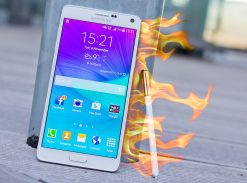The big news this week is the smoke coming from the Samsung factory. They have permanently ceased production of their much-anticipated Galaxy Note 7 which was released this summer. The company has decided to halt all sales and do a total recall of their Note 7 as a direct result of serious incidents of the phone overheating and in some cases catching fire. This is very bad news for Samsung with the Note 7 previously being hailed as one of the best smartphones released this year. Share prices have dropped by 8% almost overnight. According to reports the number of incidents globally is around 150. The problem has gotten so bad that the United States’ Federal Aviation Administration (FAA) has banned all Samsung Galaxy Note 7 phones from flights, even if they’re powered down.
Samsung traced the problem back to a fault with the smartphone’s battery. Of course, the rest of the world was quick to respond with hilarious internet memes about exploding phones. But while they are laughing, just how serious is this and what if it happens to your phone? Should we all be powering down?
The Galaxy Note 7, like almost every other smartphone out there, uses a lithium-ion battery. These batteries are used in laptops and smartphones due its capacity to store large amounts of electricity in a relatively small space. This, of course, is what all smartphone manufacturers are after, a compact phone that doesn’t require constant charging.
A lithium-ion battery is made up of three parts – the cathode, anode and a lithium electrolyte. Without getting too technical, the negative and positive bits of the battery is the anode and cathode which is separated in the middle with the electrolyte (a highly-flammable liquid). During charging lithium ions travels from the positive cathode to the negative anode, this process is reversed when the battery discharges. There is also a porous physical barrier that prevents the anode and cathode from being in direct contact, often called a diaphragm.
Basically, when the phone overheats, it is the liquid that heats up. There are a number of things that can go wrong with a lithium-ion battery and cause this overheating. Something as simple as dropping your phone (really hard on a solid surface) could cause the negative and positive poles to make direct contact and, cause the phone to start heating up and not stop. Another cause could be the compact space that is needed to create a very slim phone. If the space is so small that there is nowhere for heat to escape from, this can cause overheating to some degree. Even a manufacturing oversight, where bits of minute scrap metal have been left inside the phone can cause overheating and result in the liquid seeping through into other areas of the phone and catching fire. Furthermore, a smartphone also relies on a chip to tell it when the battery is full and to stop charging when plugged in. However, when this chip or the software fails it can lead to overcharging and, in turn, overheating. Although all smartphones heat up to a certain degree, the problem occurs when a phone keeps heating up without stopping. Scientists call this a ‘thermal runaway’ – almost like a runaway fire. When the battery reaches 200˚F, it begins to break down which causes the phone to burn and, in severe cases, catch fire.
In the case of Samsung’s Note 7, it is very possible that their desire to be market ready before the iPhone 7 hit the shelves has resulted in rush procedures being employed and somewhere an oversight occurred, either in production or in the design stages. However, they are not the only company that have been plagued by a faulty battery. In 2009 Nokia recalled millions of phone batteries due to short circuiting issues. There have also been minor reports of iPhones catching fire in 2010 and again in 2015.
So, perhaps the lesson here is that all smartphones have their limits and to take due care. Try not to drop your phone, avoid overcharging, unplug it when it is fully charged, and upgrade software as suggested. And, don’t sleep with your phone under your pillow!











